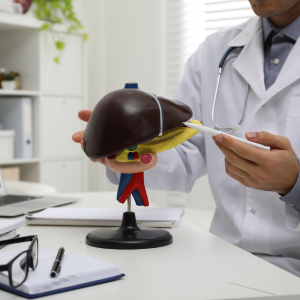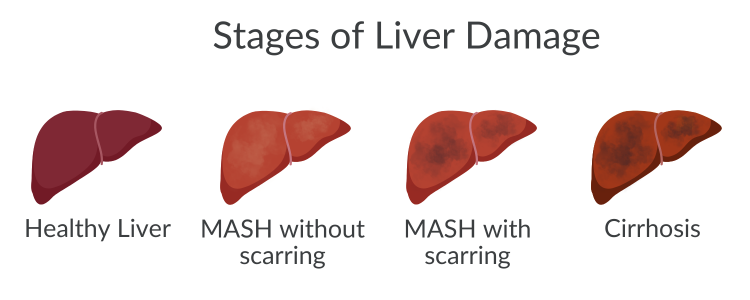Steatotic Liver Disease (SLD)

Steatotic Liver Disease (SLD) is common and happens when too much fat builds up in the liver. Your liver helps your body digest food, store energy, and get rid of toxins. It also makes proteins that help with blood clotting and other important tasks.
SLD is a term that includes conditions like MASH, MASLD, and Met-ALD. These were previously called fatty liver disease, NAFLD, and NASH.
If not treated, early stages of SLD can become MASH (Metabolic Associated Steatohepatitis), a more serious form of SLD. About 1 in 3 adults in the U.S. have SLD, and 1 in 20 adults have MASH.
If MASH is not treated, it can hurt your liver and cause other problems like heart disease or liver cancer. It can also lead to cirrhosis, which can cause liver failure or the need for a liver transplant. MASH is often found late, so it’s important to know the risk factors and symptoms.

Risk Factors
MASH is a metabolic disease. Metabolic diseases, like SLD, affect how the body uses fats and sugars. These conditions can be influenced by weight, sleep, family history, and other health problems.
Cardiometabolic Risk FactorsToo much fat in the liver or other health issues can increase the risk of MASH. These problems are often called “cardiometabolic risk factors” because they also affect the heart and blood vessels. These include:
|
Other Risk FactorsOther factors that can increase the risk include:
|
Symptoms
Some people with MASH may not feel any symptoms, or their symptoms may be mild. It is usually diagnosed by the appearance of the liver on ultrasound or CT/MRI scan. However, in some cases, the condition can progress to cirrhosis, which can lead to liver failure, liver cancer, and death. Potential symptoms can include:
- Stomach pain
- Feeling sick
- Loss of appetite
- Tiredness
- Swollen belly
Prevention
SLD can mainly be prevented by maintaining a healthy weight, exercising regularly, eating a balanced diet, avoiding excessive alcohol consumption, and managing any underlying health conditions like diabetes and high cholesterol.
Diagnosis
There are several tests to check for MASH. It’s important to note that tests are not always 100% accurate and a liver biopsy may be required to confirm the diagnosis and determine the extent of liver damage. Once a diagnosis of MASH has been made, a referral to a specialist should be considered for further work up and management.
Blood TestsBlood tests can be used to check liver function and look for signs of inflammation or damage. Elevated levels of enzymes such as ALT and AST can indicate liver damage. Some blood tests also help doctors see how much liver scarring (fibrosis) is present.
|
Fibroscan®This is a non-invasive test that can measure liver scarring and fat buildup by using ultrasound to determine the stiffness of the liver. A stiff liver may be a sign of liver damage and can indicate the presence of fatty liver. The test gives your doctors an “F” score from 0-4 (fibrosis = scarring) and an “S” score (steatohepatitis = fat) from 0-3. |
Other Imaging TestsUltrasounds, CT scans, and MRIs (like steatometry and elastography) help doctors look for changes in your liver, including liver cancer. |
Liver BiopsyThis test takes a small piece of your liver to look at under a microscope. It helps doctors see how much damage or scarring there is. |
Treatment & Management
It is important to treat SLD early since it can be reversible and untreated cases can lead to serious complications.
Lifestyle
Treatment for SLD typically includes lifestyle changes such as:
- Weight loss
- Exercise
- A healthy diet
- Stopping or cutting back on drinking alcohol
- Managing health conditions like diabetes, high blood pressure, high cholesterol, and being overweight
Here are recommendations for several conditions to help protect your liver and reduce the risk of serious liver problems like MASH:
| Type 2 Diabetes Keep your blood sugar level under control (A1C under 7%) to help prevent fat from building up in the liver. |
High Blood Pressure Keep your blood pressure under 130/80 mmHg. High blood pressure can damage the liver, so controlling it is important. |
| Cholesterol Having the right balance of cholesterol helps prevent liver fat buildup. Keep your:
|
Being Overweight/Obese Lose 5-10% of your body weight. Losing weight reduces fat in the liver, improves insulin sensitivity, and lowers the risk of liver damage. |
Medication
| Rezdiffra® (Resmetirom) This pill helps treat MASH with moderate to advanced liver damage (fibrosis score 2-3). It has been shown to reduce liver fat and scarring after 1 year. The side effects include upset stomach, diarrhea or constipation, nausea, and itching. These usually get better after a few weeks. Serious side effects include liver damage or gallbladder problems. Regular doctor visits and blood tests are needed while taking this medicine. |
GLP-1/GIP Agonists (e.g., semaglutide, tirzepatide) These medicines can help with diabetes and can cause 15-25% weight loss, which also helps improve liver health. The side effects include stomach upset, nausea, gas, bloating, constipation, diarrhea, and burping. Rare side effects include pancreatitis and thyroid tumors. |
| Other Weight Loss Medicines Losing 5-10% of your body weight improves liver health. Some weight loss medicines include:
|
Endobariatrics and Surgery
Endobariatrics and bariatric surgery can be valuable treatment options for SLD patients and can potentially improve liver related outcomes.
Long-Term Prognosis
SLD can be reversed particularly in its early stages through lifestyle modifications like weight loss, exercise, and a healthy diet. It is important to manage any underlying health conditions like diabetes and high cholesterol. SLD can also be potentially reversed particularly in patients without end stage liver disease with medications, endobariatrics, and/or bariatric surgery.